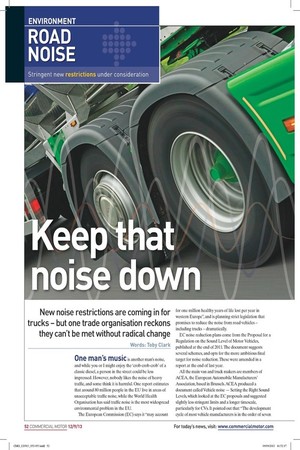ENVIRONMENT
Page 37

Page 38

If you've noticed an error in this article please click here to report it so we can fix it.
Stringent new -estrictions under consideration
New noise restrictions are coming in for trucks but one trade organisation reckons they can't be met without radical change Words: foby Clark
One man's music is another man's noise, and while you or I might enjoy the `crob-crob-crob' of a classic diesel, a person in the street could be less impressed. However, nobody likes the noise of heavy traffic, and some think it is harmful. One report estimates that around 80 million people in the EU live in areas of unacceptable traffic noise, while the World Health Organisation has said traffic noise is the most widespread environmental problem in the EU. The European Commission (EC) says it "may account
for one million healthy years of life lost per year in western Europe", and is planning strict legislation that promises to reduce the noise from road vehicles — including trucks — dramatically.
EC noise reduction plans come from the Proposal for a Regulation on the Sound Level of Motor Vehicles, published at the end of 2011. The document suggests several schemes, and opts for the more ambitious final target for noise reduction. These were amended in a report at the end of last year. All the main van and truck makers are members of ACEA, the European Automobile Manufacturers' Association, based in Brussels. ACEA produced a document called Vehicle noise — Setting the Right Sound Levels, which looked at the EC proposals and suggested slightly less stringent limits and a longer timescale, particularly for CVs. It pointed out that: "The development cycle of most vehicle manufacturers is in the order of seven
to eight years long, so lead times need to be comparable."
The proposals were voted on in the European Parliament in February, and passed as draft legislation with a number of amendments: the reduced sound limits for newly designed CVs (not existing models) are to be introduced in four phases, over 13 years and starting in 2015. The first stage sees a 2dB reduction for light vehicles and 1dB reduction for heavy vehicles; the second stage is another 1dB reduction for light and heavy vehicles, five years after the first, with further reductions at nine and 13 years after the first stage.
The final noise levels would be between 72dB(A)and 79dB(A) for heavy trucks, depending on weight and power output, although these levels are under review once the third phase is in force. Impossible to meet ACEA says a limit of 78dB(A), as originally proposed, is all but impossible to meet. "This would imply that a heavy CV, driven by an internal combustion engine with more than 250kW would produce no more sound than the battery electric equivalent. Consequently, the sound emission from only the internal combustion powertrain cannot be higher than 67dB(A). Can the best technology known in the near or even far future produce less than 67dB(A)? Given that this type of engine must simultaneously fulfill future gaseous emissions levels and consume less fuel, the answer to this question is currently 'no:" There's no need to panic just yet — the proposal still has to be implemented, and the UK government is not convinced. In April the transport under secretary Norman Baker outlined a number of objections, which a House of Commons Select Committee has largely agreed with. The objections are in line with what ACEA has said about technical feasibility and timescales, and make the point that the vehicle classifications are not always sensible — in effect, a manufacturer could put an excessively powerful engine into a vehicle in order to go into a higher noise class. In the meantime, the document remains under scrutiny. • • The ACEA document Vehicle Noise — Setting the Right Sound Levels can be downloaded from www.acea. be/index.php/files/sound_levels_of_motor_vehicles









































